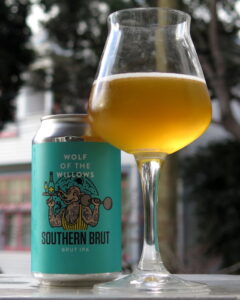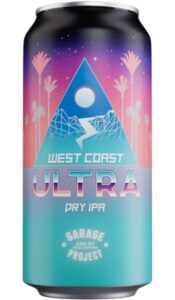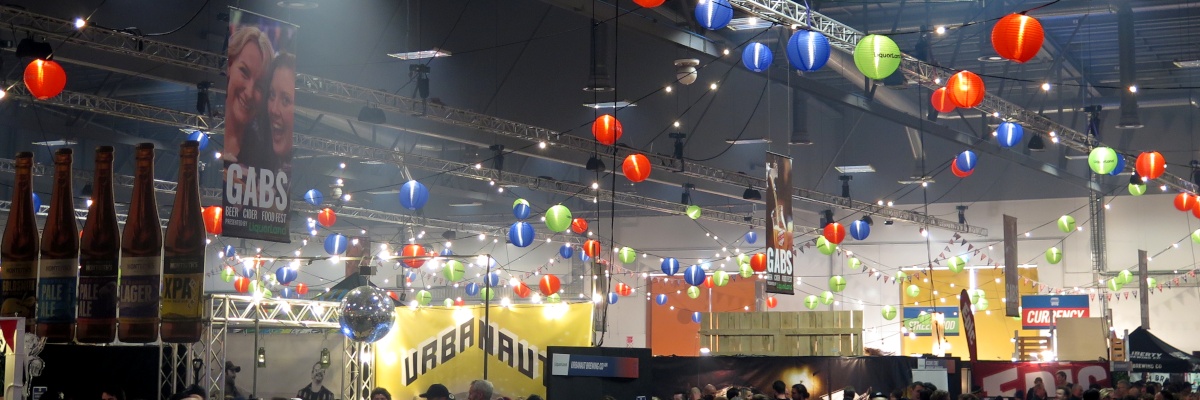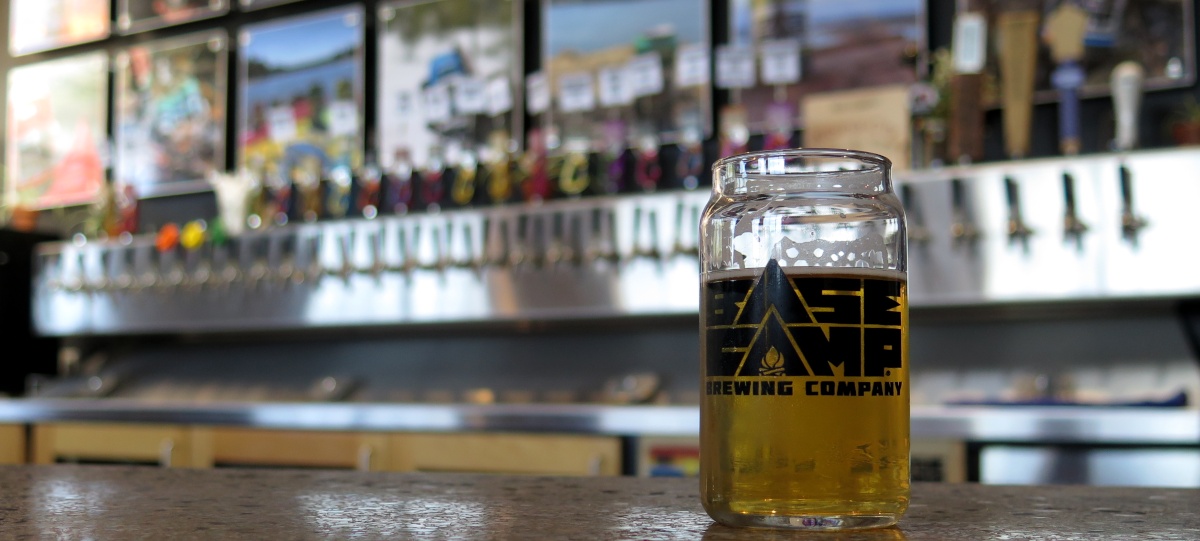
Last week, as I was helping out on a canning run at the brewery, I was listening to the ‘Why Brut IPA Never Hit It Big’ episode of the Taplines podcast,1 and it’s had me thinking and reminiscing and pondering ever since. That conversation (between journalist Dave Infante and brewer Kim Sturdavant, who developed the style and coined the name) is well worth a listen, and I don’t really disagree anywhere, but as someone who was bartending through the peak of the phenomenon and who really loved those beers, remembers them fondly and looks for their echoes to this day, I have a few thoughts to add.2
Brut IPA, if you need a reminder, was designed as a pale, lean-bodied, strong on hop character but relatively light on bitterness, and particularly dry take on its parent style — the latter often (but not always) achieved with the help of added enzymes.3 It built on trends and local variations around it at the time — pretty much everything new thing does, after all — but now it had a name, a technique, a vibe all of its own, and (briefly) looked like it might solidify into a substyle, nestled alongside West Coast IPA in the family tree. But it seemed to peak and then fade incredibly quickly.4

Indeed, all but one of the examples in my own records land between June and November of 2018.5 The ‘Southern Brut’ pictured here was a locally-hopped take from a Melbourne brewery in collaboration with the Ale Of A Time podcast,6 Christchurch’s Beer Baroness made ‘Lady Stardust’ which features at the top of this post (photographed as I cleaned Golding’s after its launch night), and I had a lot of glasses of Urbanaut’s ‘Copacabana’ on a trip to Auckland — amazingly, the latter is still in production, which nicely demonstrates that every trend (in this case, the steep downward part) has its exceptions; I’ll have to try and source some cans. The only one I found after that six-month streak was a cider-Brut-IPA hybrid at Base Camp in Portland a year later — despite being not that far removed (in either space or time) from where the style was born, sampling something like a hundred different beers during my visit to the city, and primed to actively seek it out.
From a candidate for “next big thing” to the endangered species list in a matter of months. What went wrong? Where did they go?
Dave & Kim touch on it in the podcast, but probably undersell just how confusing the new style’s name was to potential drinkers. The reference to the champagne type went over a lot of heads — and even if someone knew that the “brut” version is dry, they might not know that it means dry and so would miss what it implied about the beer. There had also (in New Zealand at least) been quite a few wine-beer hybrids kicking around in the few years before, so people often wondered if this was another. And I saw lots of folks assume that the term signaled strength or intensity — as in “brute” or “brutal” — which definitely isn’t what these beers were, and wasn’t what a lot of people wanted after years of extreme IPAs (as proven by the rise of NEIPA). All this was compounded by some of the branding used: Kim’s own original release was called ‘Hop Champagne’ and his gallery of the first ten Brut IPAs includes a number of other wine references. Other examples leaned into the suggestion of big-and-powerful with names like ‘Brut Force’ or ‘I Am Brut’. And that Wolf of the Willows one pictured above features a bottle of bubbly and a strongman character.

It’s almost as if “New England” and “Hazy” implied so little on their own that people had to ask (or learn by trying) and so got an accurate idea of the style,7 while “Brut” gave them enough to assume from but often lead them astray. The alternate history I wonder about is whether the “style” would’ve survived longer if it’d simply been called Dry IPA: simpler, easier to grasp and harder to confuse with anything else, and still a strong contrast with the other main varieties on offer at the time — namely the bitter (but often quite full and malty and/or boozy) West Coast IPA, and the distinctively juicy challenger rising from the East Coast. Garage Project dipped a toe in that direction with ‘West Coast Ultra’ Dry IPA,8 but didn’t follow it up with more — and perhaps they were consciously avoiding the “Brut IPA” designation since they’d made a number of the wine-beer hybrids I mentioned earlier, and would go on to release a ‘Bière de Champagne’ later that year. Maybe if brewers had pivoted terminology, things would’ve been different. Kim talks a bit about the unspoken feedback loop between drinkers and brewers when it comes to the success or failure of innovation and to me this all provides a great example of why that loop should be tightened and made explicit: listen to your front-line staff, train them to spot causes of confusion in your customers, and work together to smooth out sources of friction.9 For years, Range insisted on not using the word “hazy” (or any of its synonyms) on their undeniably-hazy IPAs and it lead to frequent misunderstandings at the taproom where I worked, frustrating people who were looking for those beers exactly as much as people wanting to avoid them. It shouldn’t have been such a hard fix.
But even as beers labelled Brut IPA faded away, the demand for that kind of beer still existed, whatever it was called. It was there already, remember. I agree with Dave & Kim that Brut is certainly part of the causal chain that continues into ‘West Coast Pilsner’,10 and its DNA is obvious in other recent trends like “low carb” beers and ‘Cold IPA’.11 But it was strange to not hear them mention ‘California IPA’. In New Zealand and Australia, that’s now a pretty common term for “broadly West Coast vibe, but leaner, more golden, and drier” — perhaps not to the full extent of the original Brut character, but most of the way there. These are very much my IPAs of choice at the moment, but it’s interesting to learn that as a “style term” it appears to be more common around here than it is closer to the actual California. I think it traces to a few high-profile collaborations with Green Cheek (particularly with Balter and Garage Project) given that designation, but for now it mostly serves as another lesson in the vagaries of the evolution of ways of brewing and of categorising beer. And ‘Bright IPA’ might yet supplant that as the common term; Parrotdog have been using it for a while,12 and I’ve seen some mention of its influence over here. It has the advantage of simplicity and directness (like Dry IPA might’ve had), and lacks the burden of a potentially confusing geographic term. We’ll see.

Perhaps the simple truth is that it’s unsurprising Brut IPA didn’t solidify into a substyle because very few intentional coinages like that ever last. Cultural evolution — whether of language, or genres of whatever media, or indeed beer styles — is messier than that and it resists attempts to shove it in one direction or another.13 Jeff Alworth made some excellent observations on the problem of overthinking ‘styles’ and how trying to shoe-horn every trend into those terms obscures interesting questions about culture. That’s where the action is, and why I try to pay attention to how “normal people” react to some new innovation. You can’t just make up a new word unilaterally; everyone else has to understand what you meant by it and find it useful enough that they adopt it too.
Maybe we wonder about the “rise and fall” of this particular thing so much partly by accident of timing: in the late 2010s “craft beer” was flourishing and a huge amount of attention was being paid to it, both from professionals and the wider circles of engaged folks on social media. A hundred years ago, if you had a quirky personal take on a regionally-popular kind of beer, hardly anyone would ever find out if it didn’t take off.14 It wouldn’t leave enough fossil evidence. Brut IPA hit a weird sweet spot of being just famous enough to be missed when it tailed off. But it left behind some good lessons in how these things evolve and I’m grateful to that podcast episode for a reason to look back. Plus, I really liked those beers.

- Conveniently available on YouTube or — as they say — wherever you get your podcasts.
- Plus, not for nothing, it really does feel like old-school blogging to properly tee off from something like that rather than make a few ephemeral replies on social media. And I missed blogging (and podcasting), to be honest.
- Which could convert unfermentable sugars into ones that yeast could process into booze and bubbles, thereby lowering the finished beer’s sweetness.
- Mid-2018, local beer writers were gathering brewers together to ponder its potential, and wondering about the deeper implications of the techniques often involved. As soon as 2020, there were already pieces with “rise and fall” in their title. And check out all the 2018 datelines in the articles on Kim’s own Brut IPA site, underneath a link to the above podcast, with nothing in between.
- None of them got an actual Diary entry of their own, which feels now feels unfair. But I pay for Untappd and use it as a supplementary memory aid, so I downloaded all my data from there and went looking.
- Luke’s end-of-year roundup had Brut IPA as “more of a slow burn than NEIPA but… here to stay”. My cans were a Patreon supporter bonus.
- Personally, I’ve always wondered if people were subconsciously associating Hazy IPA with other hazy beers they’ve already experienced. With low-bitterness styles wheat beer and — in this part of the world — other examples like Cooper’s Sparkling / Pale and Stone & Wood ‘Pacific Ale’, that would actually serve you pretty well in getting a handle on what to expect.
- Given the timing (mid 2018) and the “low carb” references in the blurb, I’m pretty comfortable saying it was a Brut IPA, for present purposes.
- Goddamnit. All this time I thought I had a “normal” job, but it turns out I’m at least partially a UX designer, aren’t I?
- This needs a post of its own, but I humbly submit “Pacific Pilsner” as an alternative style term, since so many of them (even those brewed on the U.S. West Coast) seem to involve New Zealand hops — and “New World Pilsner” (which you sometimes see used instead) has tacky colonial overtones.
- The promotion (or just normalisation) of those sugar-converting enzymes must have helped bring “low carb” beers into so many portfolios (indeed, Urbanaut actually use the word “Brut” on theirs). Meanwhile, given Cold IPA’s mix of interesting technique, appealing flavour profile, and confusing terminology, the parallels are obvious.
- Fairly hefty disclaimer here: I’ve written a lot of label text for the brewery over the last decade or so. I had nothing to do with coining Bright IPA, but was a big supporter of the idea and wrote the blurbs for several beers of that type.
- Something else that needs a post of its own — I should’ve known this would spiral out of control — is a look at Asahi / CUB’s attempt to create a style with “Australian Wheat Ale”, contrasting that with how Stone & Wood kind of accidentally made one with Pacific Ale.
- At least not until Ron Pattinson came along and trawled your archive. Also, breweries of today: I hope you do give some thought to your archive. Keeping things in an app some shitbag company can disappear without warning doesn’t count.

In this neck of the woods (Netherlands), while I wouldn’t say they’re very common, they do seem to be hanging around a bit. It’s not uncommon for a brut beer of some sort to be on tap at one of my locals. The only one right now though is a (pretty nice) lambic.
So this is breweries using “brut” in the wine sense of “dry”, yeah? I suppose people are more likely to know the actual meaning of it, in Europe. Or are you seeing “Brut IPA” as such as well? A few people have sent me other examples from around the place, so I’m curious to see where it’s still clinging to life!
Hey! It’s me, Kim. I’m glad you enjoyed the podcast. I enjoyed reading this Blog article and I think you have some great insights that align with my own thoughts.
For ‘California IPA,’ you are correct that it’s off our radar in California already. At least, I think it is.
When Green Cheek started labeling their creations as such, I knew what they were referencing (light color, low bitterness, clear IPA), but consumers had yet one more type of IPA to decipher. I labeled some of my beers as California IPA around 2020-2021, our staff/customers/retailers were confused, so I stopped using that term and called them West Coast IPA. They were just particular products that were lower on bitterness than our other West Coast IPAs.
For better or for worse, at least in the SF Bay Area, IPAs are either ‘Hazy’ or ‘West Coast’ at the moment. If I make a 100% barley IPA that’s bitter, reasonably lean, but also hazy… it shall be referred to as Hazy IPA. From the customer’s perspective, it makes the most sense, since there is so much variation already within all of the IPA sub-styles between producers.
For breweries like Green Cheek, though, that make so much IPA for a devoted following; enough of their customers get it that it works. Likewise, with Cellarmaker and their ‘West Coast Hazy’ beers.
Hey Kim! Thanks for dropping by and for the extra context. Super interesting how this stuff varies from place to place and time to time.
I’ve definitely spent quite a bit of time explaining ‘California IPA’ lately but I think the sunny connotations and the fact it’s a subset of ‘West Coast’ both geographically and stylistically is helping it work well enough for now.
I feel like a customer here would flinch away from a bitter-but-hazy beer being labelled as a “hazy” here. I can imagine they’d say it wasn’t a “proper” hazy if it strayed too far from having that juicy character in charge, whatever it looked like. I can’t think of many local examples that have tested that, though…